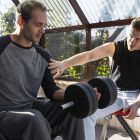Why is your grandfather walk with a tilt forward? Ankylosing Spondylitis could be to blame (AS). Yes, roughly 0.1 per cent to 0.5 per cent of the adult population is affected. Spondylitis hits men in their early twenties, which is even more shocking. In women, it is less common. It’s alarming to learn that Ankylosing Spondylitis can impair your eyes, heart, lungs, and kidneys in extreme cases.
Ankylosing Spondylitis —- Definition
Ankylosing Spondylitis is an autoimmune illness that affects the spine. It’s a type of arthritis that affects your spine mostly. The joints in your spine are called vertebrae, and they become inflamed in Ankylosing Spondylitis, causing discomfort, severe pain, and chronic agony. In extreme cases, there’s a potential that new bone will develop, fusing your spine. You may become immobile or have a forward-stopped posture. Kyphosis is the medical word for this stopped position.
What causes and symptoms of Ankylosing Spondylitis?
Cause
The causes are yet not known why people develop AS, but according to research, people with HLA-B27 genes are more likely to be at risk of developing Ankylosing Spondylitis.
Symptoms
The symptoms for Ankylosing Spondylitis which people commonly observe, are:
- Coughing too much
- a stooping forward position
- The lower backache that doesn’t go away
- Tiredness and a loss of appetite
- Near the tendons and ligaments, there is inflammation.
- After engaging in strenuous physical exercise, you may have joint pain.
Who all are at Serious risk of Ankylosing Spondylitis:
- If you have a background history of Ankylosing Spondylitis, you should be cautious.
- If you test positive for the HLA-B27 gene,
- If you have a lot of infections in your digestive tract
Effects of Ankylosing Spondylitis on other body parts:
It certainly does! Ankylosing spondylitis can also affect your shoulders, heels, ribs, hips, and minor joints in your hands and feet, causing inflammation, stiffness, and pain. However, your eyes may be harmed in a very small percentage of cases.
Diagnosis for Ankylosing Spondylitis
Your symptoms, physical examination, X-ray reports of your back and pelvis, chest measures while breathing, and the findings of laboratory investigations are all used to make the diagnosis of Ankylosing Spondylitis AS.
What are the treatments for Ankylosing Spondylitis?
Ankylosing Spondylitis AS has no specific treatment. However, the treatment’s goals include lowering stiffness, discomfort, and pain.
- Exercise: Performing regular workouts is a great way to relieve stiffness and build muscles. Regular exercise helps to reduce the risk of becoming disabled. Swimming is a good exercise for persons with Ankylosing Spondylitis, according to your doctor.
- Physical therapy: Physical therapy is the greatest early intervention for retaining or maintaining physical function. It aids in the reduction of malformation.
- Drugs: Drugs provide pain relief and allow you to go about your everyday activities without suffering. NSAIDs, disease-modifying anti-rheumatoid medications, steroid injections, and antidepressants are some treatments that may be used.
- Surgery: In the case of Ankylosing Spondylitis AS, surgery may be the last resort. However, if you are in excruciating pain due to joint damage, your doctor may propose surgery.
- As a result, the blog, as mentioned above, offers all of the important information on Ankylosing Spondylitis. However, effective therapy from specialists is essential to grasp the security of the situation, relieve pain, and prevent a recurrence. Orthocure’s staff of experienced orthopaedists, physiotherapists, and chiropractors can assist you. We do a complete analysis of your problem to identify the root cause and deliver an accurate diagnosis. We devise a plan for you based on your lifestyle and the severity of your musculoskeletal condition. Our motive is to help you live a better life by alleviating the pain caused by your bone and muscle illness.





